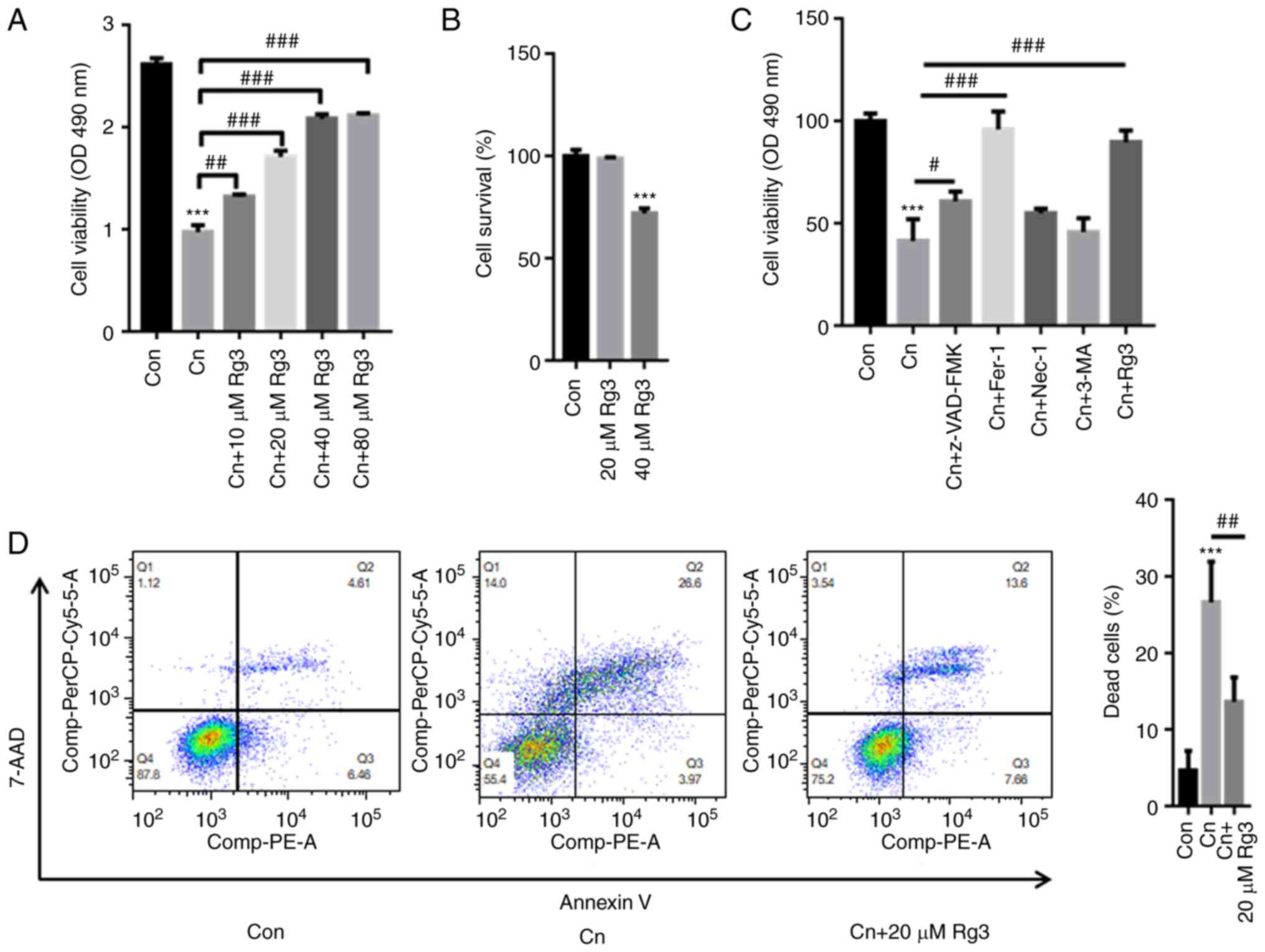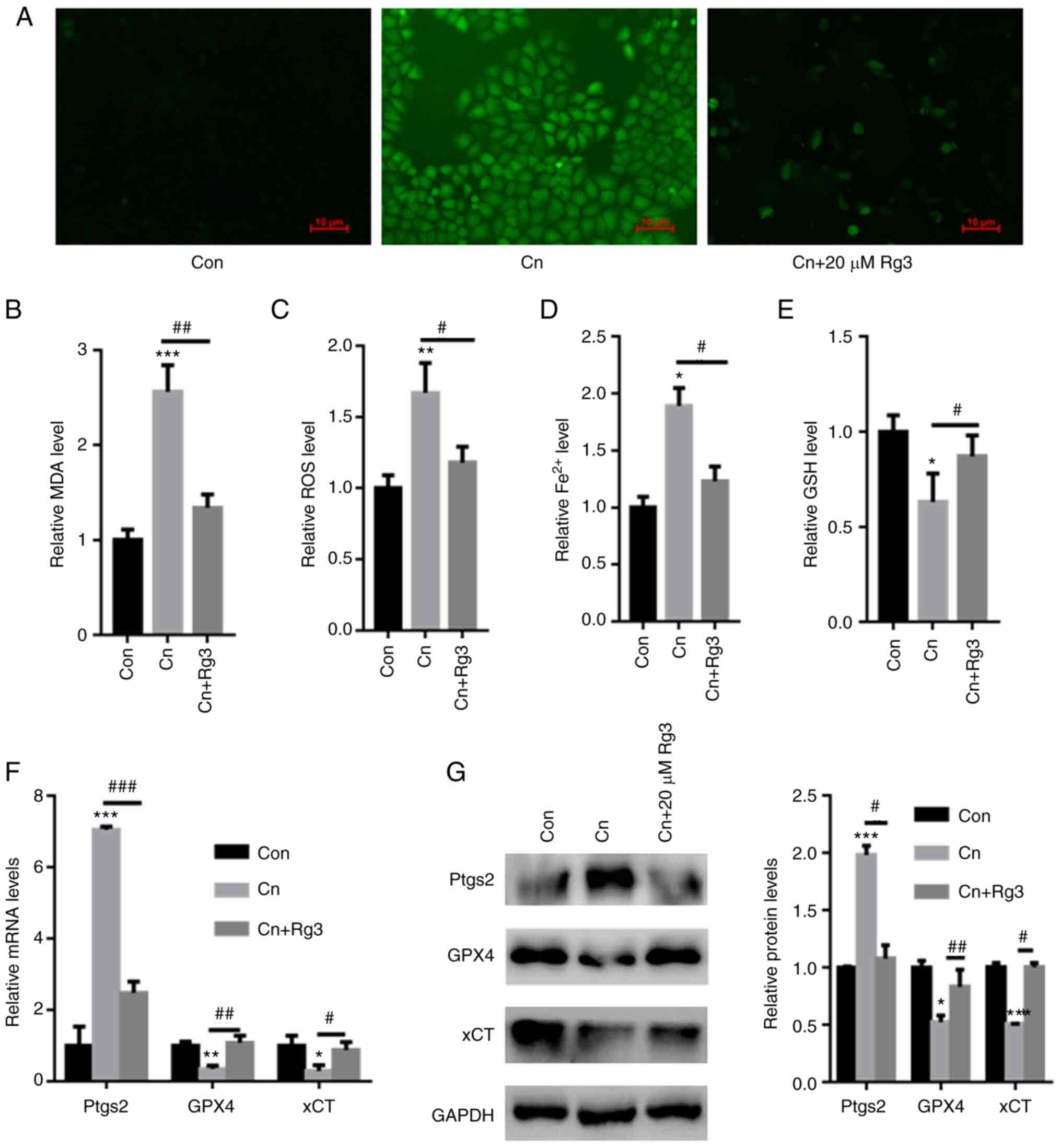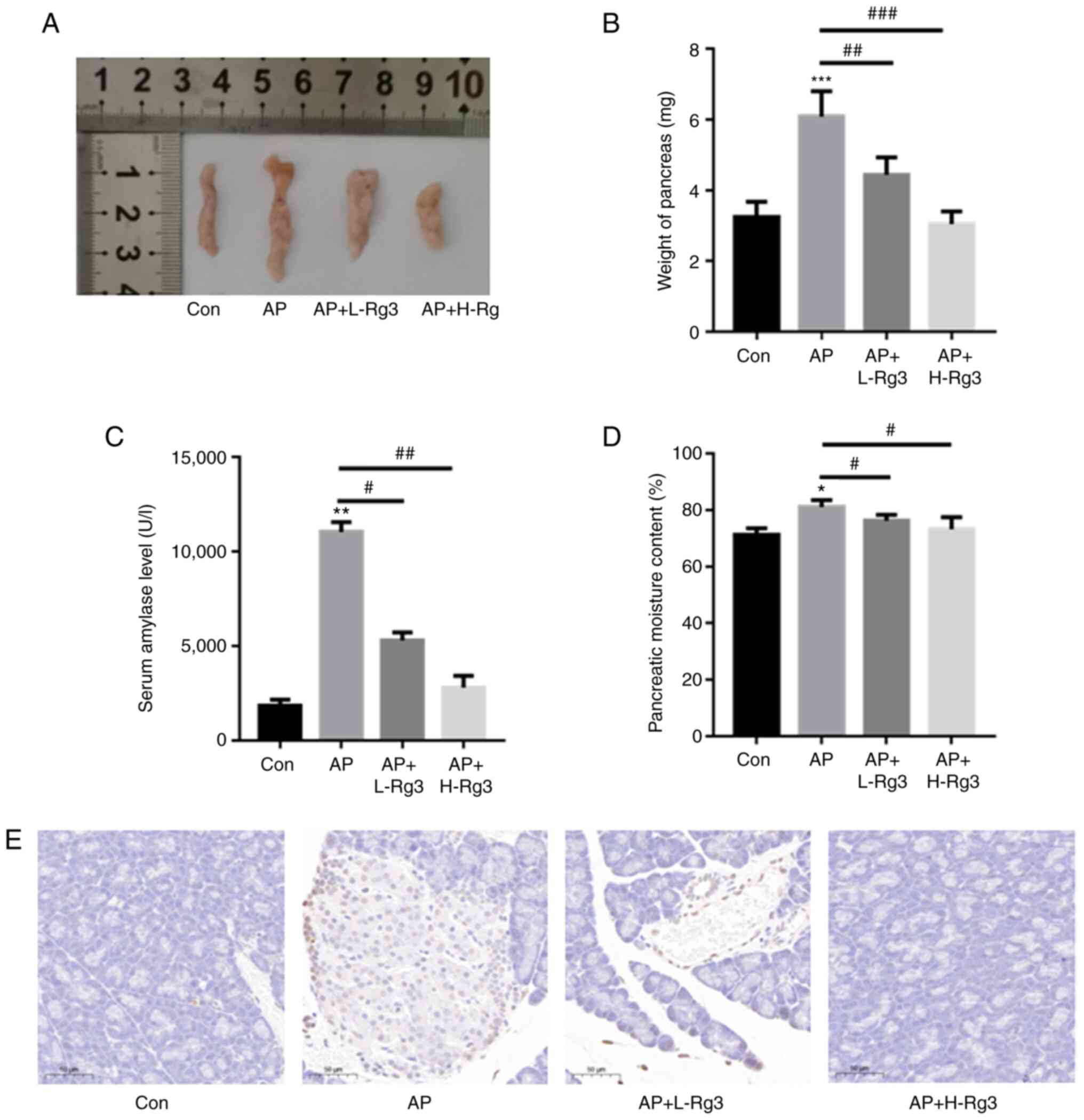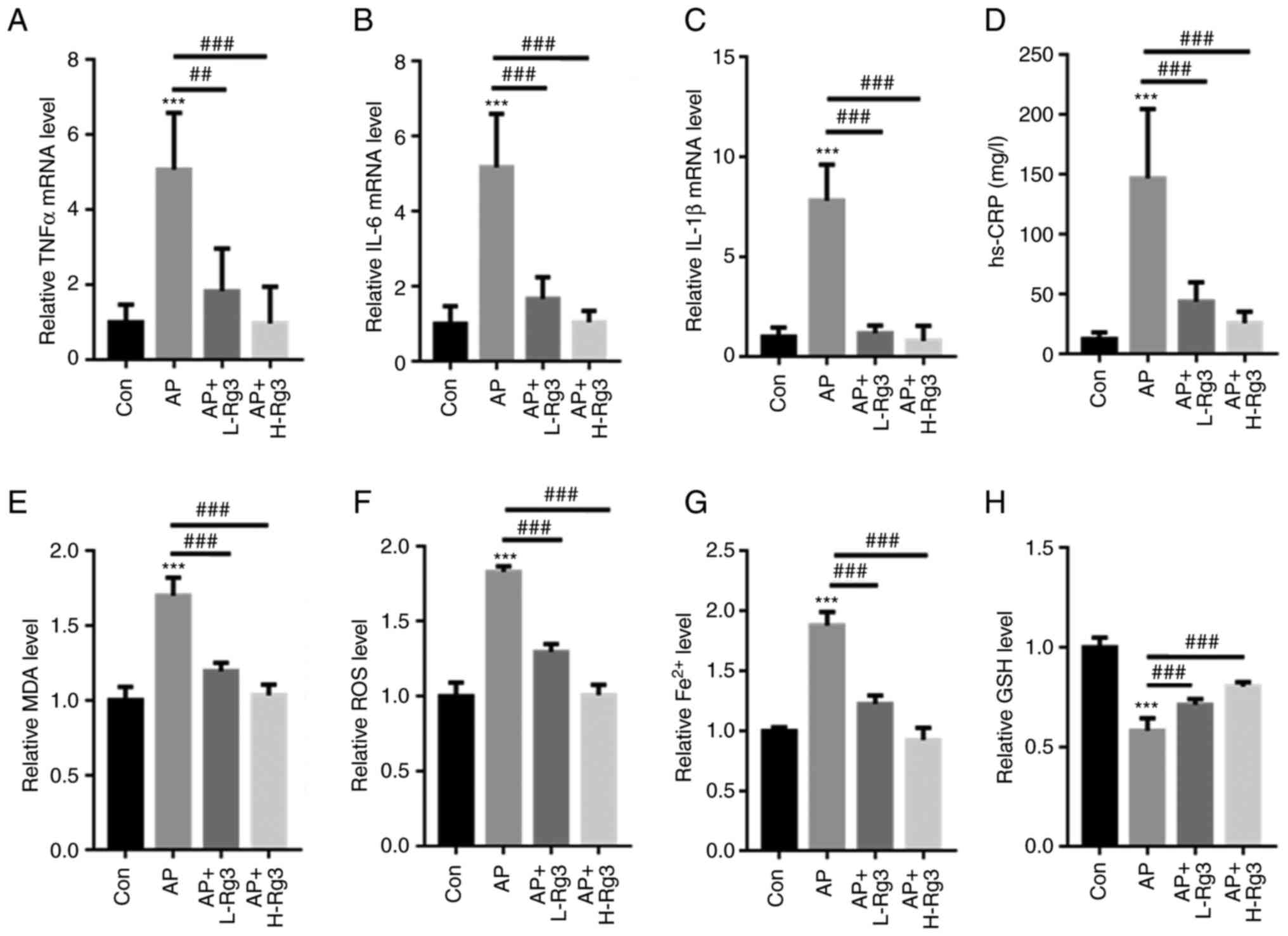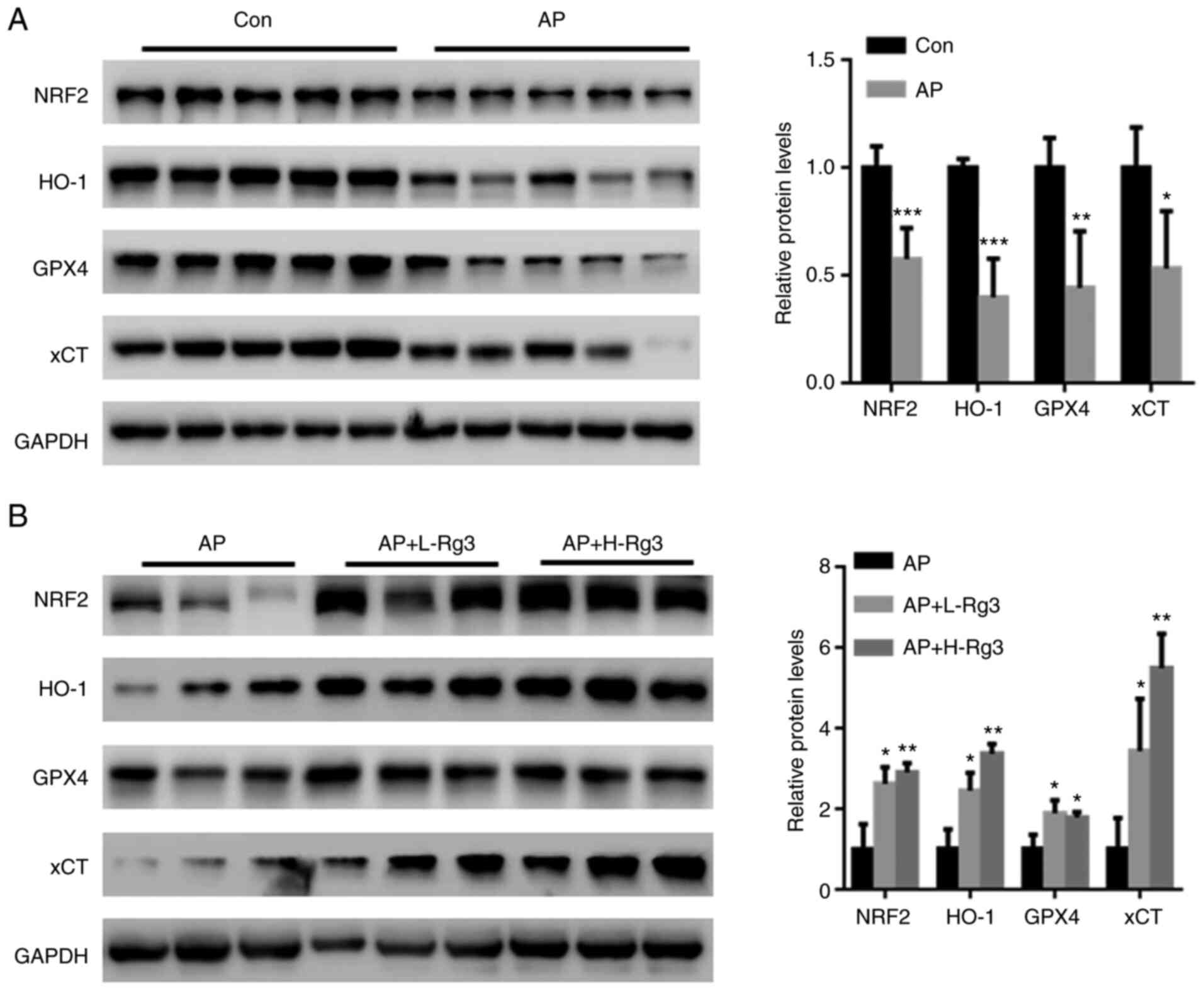|
1
|
Gliem N, Ammer-Herrmenau C, Ellenrieder V
and Neesse A: Management of severe acute pancreatitis: An update.
Digestion. 102:503–507. 2021. View Article : Google Scholar
|
|
2
|
Petrov MS and Yadav D: Global epidemiology
and holistic prevention of pancreatitis. Nat Rev Gastroenterol
Hepatol. 16:175–184. 2019. View Article : Google Scholar :
|
|
3
|
Wang J, Chen G, Gong H, Huang W, Long D
and Tang W: Amelioration of experimental acute pancreatitis with
Dachengqi Decoction via regulation of necrosis-apoptosis switch in
the pancreatic acinar cell. PLoS One. 7:e401602012. View Article : Google Scholar : PubMed/NCBI
|
|
4
|
Huang DY, Li Q, Shi CY, Hou CQ, Miao Y and
Shen HB: Dexmedetomidine attenuates inflammation and pancreatic
injury in a rat model of experimental severe acute pancreatitis via
cholinergic anti-inflammatory pathway. Chin Med J (Engl).
133:1073–1079. 2020. View Article : Google Scholar
|
|
5
|
Schepers NJ, Bakker OJ, Besselink MG,
Ahmed Ali U, Bollen TL, Gooszen HG, van Santvoort HC and Bruno MJ;
Dutch Pancreatitis Study Group: Impact of characteristics of organ
failure and infected necrosis on mortality in necrotising
pancreatitis. Gut. 68:1044–1051. 2019. View Article : Google Scholar
|
|
6
|
Jain S, Mahapatra SJ, Gupta S, Shalimar
Shalimar and Garg PK: Infected pancreatic necrosis due to
multidrug-resistant organisms and persistent organ failure predict
mortality in acute pancreatitis. Clin Transl Gastroenterol.
9:1902018. View Article : Google Scholar : PubMed/NCBI
|
|
7
|
Schneider L, Jabrailova B, Strobel O,
Hackert T and Werner J: Inflammatory profiling of early
experimental necrotizing pancreatitis. Life Sci. 126:76–80. 2015.
View Article : Google Scholar : PubMed/NCBI
|
|
8
|
Yu H, Guo P, Xie X, Wang Y and Chen G:
Ferroptosis, a new form of cell death, and its relationships with
tumourous diseases. J Cell Mol Med. 21:648–657. 2017. View Article : Google Scholar :
|
|
9
|
Hassannia B, Vandenabeele P and Vanden
Berghe T: Targeting ferroptosis to iron out cancer. Cancer Cell.
35:830–849. 2019. View Article : Google Scholar : PubMed/NCBI
|
|
10
|
Friedmann Angeli JP, Schneider M, Proneth
B, Tyurina YY, Tyurin VA, Hammond VJ, Herbach N, Aichler M, Walch
A, Eggenhofer E, et al: Inactivation of the ferroptosis regulator
Gpx4 triggers acute renal failure in mice. Nat Cell Biol.
16:1180–1191. 2014. View
Article : Google Scholar : PubMed/NCBI
|
|
11
|
Yang WS, SriRamaratnam R, Welsch ME,
Shimada K, Skouta R, Viswanathan VS, Cheah JH, Clemons PA, Shamji
AF, Clish CB, et al: Regulation of ferroptotic cancer cell death by
GPX4. Cell. 156:317–331. 2014. View Article : Google Scholar : PubMed/NCBI
|
|
12
|
Ma D, Li C, Jiang P, Jiang Y, Wang J and
Zhang D: Inhibition of ferroptosis attenuates acute kidney injury
in rats with severe acute pancreatitis. Dig Dis Sci. 66:483–492.
2021. View Article : Google Scholar
|
|
13
|
Wei S, Qiu T, Yao X, Wang N, Jiang L, Jia
X, Tao Y, Wang Z, Pei P, Zhang J, et al: Arsenic induces pancreatic
dysfunction and ferroptosis via mitochondrial
ROS-autophagy-lysosomal pathway. J Hazard Mater. 384:1213902020.
View Article : Google Scholar
|
|
14
|
Hu S, Zhu Y, Xia X, Xu X, Chen F, Miao X
and Chen X: Ginsenoside Rg3 prolongs survival of the orthotopic
hepatocellular carcinoma model by inducing apoptosis and inhibiting
angiogenesis. Anal Cell Pathol (Amst). 2019:38157862019.
|
|
15
|
Zou J, Su H, Zou C, Liang X and Fei Z:
Ginsenoside Rg3 suppresses the growth of gemcitabine-resistant
pancreatic cancer cells by upregulating lncRNA-CASC2 and activating
PTEN signaling. J Biochem Mol Toxicol. 34:e224802020. View Article : Google Scholar : PubMed/NCBI
|
|
16
|
Chen F, Chen Y, Kang X, Zhou Z, Zhang Z
and Liu D: Anti-apoptotic function and mechanism of ginseng
saponins in Rattus pancreatic beta-cells. Biol Pharm Bull.
35:1568–1573. 2012. View Article : Google Scholar
|
|
17
|
Yuan HD, Kim JT, Kim SH and Chung SH:
Ginseng and diabetes: The evidences from in vitro, animal and human
studies. J Ginseng Res. 36:27–39. 2012. View Article : Google Scholar : PubMed/NCBI
|
|
18
|
Kim YJ, Park SM, Jung HS, Lee EJ, Kim TK,
Kim TN, Kwon MJ, Lee SH, Rhee BD, Kim MK and Park JH: Ginsenoside
Rg3 prevents INS-1 cell death from intermittent high glucose
stress. Islets. 8:57–64. 2016. View Article : Google Scholar : PubMed/NCBI
|
|
19
|
Kim M, Ahn BY, Lee JS, Chung SS, Lim S,
Park SG, Jung HS, Lee HK and Park KS: The ginsenoside Rg3 has a
stimulatory effect on insulin signaling in L6 myotubes. Biochem
Biophys Res Commun. 389:70–73. 2009. View Article : Google Scholar : PubMed/NCBI
|
|
20
|
Jeong YK and Kim H: A mini-review on the
effect of docosahexaenoic acid (DHA) on cerulein-induced and
hypertriglyceridemic acute pancreatitis. Int J Mol Sci.
18:22392017. View Article : Google Scholar :
|
|
21
|
Xian Y, Wu Y, He M, Cheng J, Lv X and Ren
Y: Sleeve gastrectomy attenuates the severity of cerulein-induced
acute pancreatitis in obese rats. Obes Surg. 31:4107–4117. 2021.
View Article : Google Scholar : PubMed/NCBI
|
|
22
|
Hagar HH, Almubrik SA, Attia NM and
Aljasser SN: Mesna alleviates cerulein-induced acute pancreatitis
by inhibiting the inflammatory response and oxidative stress in
experimental rats. Dig Dis Sci. 65:3583–3591. 2020. View Article : Google Scholar : PubMed/NCBI
|
|
23
|
Malla SR, Krueger B, Wartmann T, Sendler
M, Mahajan UM, Weiss FU, Thiel FG, De Boni C, Gorelick FS, Halangk
W, et al: Early trypsin activation develops independently of
autophagy in caerulein-induced pancreatitis in mice. Cell Mol Life
Sci. 77:1811–1825. 2020. View Article : Google Scholar
|
|
24
|
Livak KJ and Schmittgen TD: Analysis of
relative gene expression data using real-time quantitative PCR and
the 2(-Delta Delta C(T)) Method. Methods. 25:402–408. 2001.
View Article : Google Scholar
|
|
25
|
Dodson M, Castro-Portuguez R and Zhang DD:
NRF2 plays a critical role in mitigating lipid peroxidation and
ferroptosis. Redox Biol. 23:1011072019. View Article : Google Scholar : PubMed/NCBI
|
|
26
|
Gao Z, Sui J, Fan R, Qu W, Dong X and Sun
D: Emodin protects against acute pancreatitis-associated lung
injury by inhibiting NLPR3 inflammasome activation via Nrf2/HO-1
signaling. Drug Des Devel Ther. 14:1971–1982. 2020. View Article : Google Scholar : PubMed/NCBI
|
|
27
|
Wu K, Yao G, Shi X, Zhang H, Zhu Q, Liu X,
Lu G, Hu L, Gong W, Yang Q and Ding Y: Asiaticoside ameliorates
acinar cell necrosis in acute pancreatitis via toll-like receptor 4
pathway. Mol Immunol. 130:122–132. 2021. View Article : Google Scholar
|
|
28
|
Chen X, Yu C, Kang R, Kroemer G and Tang
D: Cellular degradation systems in ferroptosis. Cell Death Differ.
28:1135–1148. 2021. View Article : Google Scholar : PubMed/NCBI
|
|
29
|
Sun Y, Chen P, Zhai B, Zhang M, Xiang Y,
Fang J, Xu S, Gao Y, Chen X, Sui X and Li G: The emerging role of
ferroptosis in inflammation. Biomed Pharmacother. 127:1101082020.
View Article : Google Scholar : PubMed/NCBI
|
|
30
|
Xu T, Ding W, Ji X, Ao X, Liu Y, Yu W and
Wang J: Molecular mechanisms of ferroptosis and its role in cancer
therapy. J Cell Mol Med. 23:4900–4912. 2019. View Article : Google Scholar : PubMed/NCBI
|
|
31
|
Wei X, Chen J, Su F, Su X, Hu T and Hu S:
Stereospecificity of ginsenoside Rg3 in promotion of the immune
response to ovalbumin in mice. Int Immunol. 24:465–471. 2012.
View Article : Google Scholar : PubMed/NCBI
|
|
32
|
Lee IS, Uh I, Kim KS, Kim KH, Park J, Kim
Y, Jung JH, Jung HJ and Jang HJ: Anti-inflammatory effects of
ginsenoside Rg3 via NF-ĸB pathway in A549 cells and human asthmatic
lung tissue. J Immunol Res. 2016:75216012016. View Article : Google Scholar
|
|
33
|
Tsai K, Wang SS, Chen TS, Kong CW, Chang
FY, Lee SD and Lu FJ: Oxidative stress: An important phenomenon
with pathogenetic significance in the progression of acute
pancreatitis. Gut. 42:850–855. 1998. View Article : Google Scholar : PubMed/NCBI
|
|
34
|
Pereda J, Sabater L, Aparisi L, Escobar J,
Sandoval J, Viña J, López-Rodas G and Sastre J: Interaction between
cytokines and oxidative stress in acute pancreatitis. Curr Med
Chem. 13:2775–2787. 2006. View Article : Google Scholar : PubMed/NCBI
|
|
35
|
Booth DM, Murphy JA, Mukherjee R, Awais M,
Neoptolemos JP, Gerasimenko OV, Tepikin AV, Petersen OH, Sutton R
and Criddle DN: Reactive oxygen species induced by bile acid induce
apoptosis and protect against necrosis in pancreatic acinar cells.
Gastroenterology. 140:2116–2125. 2011. View Article : Google Scholar : PubMed/NCBI
|
|
36
|
Su LJ, Zhang JH, Gomez H, Murugan R, Hong
X, Xu D, Jiang F and Peng ZY: Reactive oxygen species-induced lipid
peroxidation in apoptosis, autophagy, and ferroptosis. Oxid Med
Cell Longev. 2019:50808432019. View Article : Google Scholar : PubMed/NCBI
|
|
37
|
Stockwell BR, Friedmann Angeli JP, Bayir
H, Bush AI, Conrad M, Dixon SJ, Fulda S, Gascón S, Hatzios SK,
Kagan VE, et al: Ferroptosis: A regulated cell death nexus linking
metabolism, redox biology, and disease. Cell. 171:273–285. 2017.
View Article : Google Scholar : PubMed/NCBI
|
|
38
|
Armstrong JA, Cash N, Soares PM, Souza MH,
Sutton R and Criddle DN: Oxidative stress in acute pancreatitis:
Lost in translation? Free Radic Res. 47:917–933. 2013. View Article : Google Scholar : PubMed/NCBI
|
|
39
|
Dong H, Qiang Z, Chai D, Peng J, Xia Y, Hu
R and Jiang H: Nrf2 inhibits ferroptosis and protects against acute
lung injury due to intestinal ischemia reperfusion via regulating
SLC7A11 and HO-1. Aging (Albany NY). 12:12943–12959. 2020.
View Article : Google Scholar
|
|
40
|
Yuan Y, Zhai Y, Chen J, Xu X and Wang H:
Kaempferol ameliorates oxygen-glucose
deprivation/reoxygenation-induced neuronal ferroptosis by
activating Nrf2/SLC7A11/GPX4 Axis. Biomolecules. 11:9232021.
View Article : Google Scholar : PubMed/NCBI
|
|
41
|
Liu X, Zhu Q, Zhang M, Yin T, Xu R, Xiao
W, Wu J, Deng B, Gao X, Gong W, et al: Isoliquiritigenin
ameliorates acute pancreatitis in mice via inhibition of oxidative
stress and modulation of the Nrf2/HO-1 pathway. Oxid Med Cell
Longev. 2018:71615922018. View Article : Google Scholar : PubMed/NCBI
|















